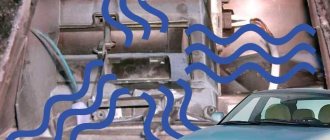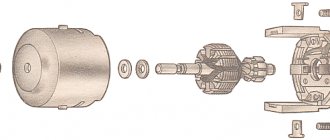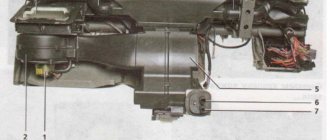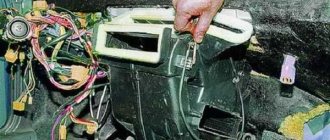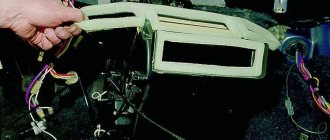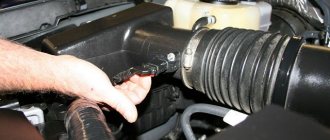This is not to say that the heating system in the Lada Priora is completely bad, but there are still some shortcomings. Therefore, with the onset of the first cold weather, the owners of this VAZ begin to eliminate breakdowns that make driving a car simply impossible. Problems can be of a very different nature, for example, the heater does not blow at your feet. In this regard, the Priora can be called a very problematic car. But not everything is so scary and doable even without the involvement of specialists.
Why the stove does not blow at the feet on the Lada Priora and what to do
Problems with the stove are inherent in many models that came off the VAZ assembly line, and the Lada Priora inherited them from its predecessor from the tenth “family”. To better understand possible problems, you should know what the heating stove in the car consists of. Its main structural elements are:
- heating element assembly;
- a heated air flow distribution reducer, distributing it vertically or onto the windshield;
- air temperature sensor, which is located on the ceiling of the cabin;
- controller or stove control unit, which is located on the front panel and serves to control the driver;
- an additional resistor that regulates the fan rotation speed is located in the engine compartment;
- electric heater fan located under the hood of the car;
- a heating system damper motor, which is located inside the heater and regulates the air flow in the “indoor/outdoor” mode;
- air filter;
- the heater radiator, which is located inside the heater.
Upon closer examination of the above list, the principle of operation of the stove, as well as the main possible malfunctions in its operation, can be understood. In general, it is worth noting that the operating modes, in particular the direction of the heated air flow, are determined by the driver, while the degree of required heating is determined automatically by a sensor.
Collective farm tuning of the Niva Chevrolet stove: we make it blow into our feet
One of the ways to solve the problem of poor foot airflow.
In some cases, the correct switching method does not work and then you have to modify the heater to achieve full functionality.
The main problem with dampers and ducts is leakage.
We will improve the cracks and eliminate leaks in the stove.
Warm air simply spreads throughout the cabin, escaping through leaks in the dampers and air ducts. Naturally, each specific car has its own gaps in the heating system, so there cannot be a single treatment recipe.
However, with little effort, without removing the front panel and the entire heater, you can modify the guides for the dampers so that the main flow of warm air is supplied to the feet. To do this, you need to remove the casing from the console on the driver's side and, if desired, the steering column casing .
In front of us on the stove side is a die , which is responsible for the direction of movement of both dampers, and therefore the direction of air supply. All that remains is to unscrew the die with the slots, change the shape in the uppermost slot from curved to straight, maintaining the starting and ending points.
A radical solution to the problem of poor foot airflow is to close one damper AT ALL with foam rubber.
Having changed the geometry of the movement of the upper damper, it remains to firmly fix the lower one, which is responsible for blowing the legs. It is enough to fix the lever of the lower damper with a self-tapping screw in the position of blowing the legs. Now there will be constantly warm air in the legs, and its quantity and proportions between the windshield and the legs are smoothly selected by a conventional air direction regulator. This way you can come to an agreement with the Niva Chevrolet stove and make it evenly warm up the interior.
The main types of stove malfunction in the Lada Priora and how to eliminate them
There are several main types of heater malfunctions in a Lada Priora car, which are characterized by the fact that heated air enters the cabin poorly, it can be cold, in some cases the heater does not blow into the feet at all.
As experts note, one of the main reasons for such malfunctions may be a malfunction of the stove damper, which is jammed.
In some cases, the damper becomes uncontrollable due to a break in the damper cable or a break in the metal lever that tensions the cable that controls the damper.
Another type of failure is the failure of the gearbox. In the Lada Priora it consists of plastic, so the only option for troubleshooting is to replace such a gear with a new one, which must be purchased.
From the experience of repairing car stoves, it is timely to conclude that filters are often clogged in them, which significantly complicates the passage of air. Also, when disassembling the stove, you can find a large amount of dirt and leaves in the system elements, starting with the radiator, which is in contact with the external environment. In such cases, and this is obvious, air obstruction in the system can be eliminated by freeing the structural elements along the air movement, dirt, leaves and other foreign objects, as well as by thoroughly cleaning the radiator and filter.
In some cases, it happens that hot air is constantly coming out of the stove. This may be due to a sensor failure. It’s time to try turning it off for a while and check how the stove will work in this mode. This can also happen due to a failure of the gear motor or a malfunction of the heater heater control unit. If there is an increased noise level in the cabin when the stove is operating, the main cause is a fan malfunction.
There are situations when the stove does not turn on at all. In this case, most likely, we can say that the fuse has blown, which can be easily fixed by replacing it. If the failure is due to a failure of the control unit, then everything is much more serious and you should contact a workshop.
Summing up, we can conclude that most of the breakdowns that lead to complete or partial failure of the stove on a Lada Priora car are mechanical in nature in the form of structural destruction of individual elements or their clogging. In this case, it is recommended to contact a service center (especially if the car is under warranty) or a service station, where qualified specialists will determine the cause of the breakdown and be able to eliminate it.
However, car enthusiasts themselves, especially those with extensive experience, can independently understand the situation and often eliminate it themselves. Fortunately, most parts for the Lada Priora are not in serious shortage on the Russian market. Meanwhile, according to many Russian car owners who use products of the domestic automobile industry, the stove is considered one of the most unreliable components in the Lada Priora.
Content
Why doesn't the heater work and blows cold air on the Priora? There are many reasons for this. In descending order of frequency of cases, they can be arranged as follows:
- The stove damper is stuck. It does not open and does not allow warm air into the cabin. By the way, the opposite option is also possible: if it is closed in the open position, you begin to feel like you are in a sauna;
- The heating gear motor is broken;
- The stove control unit does not work;
- Problems in the engine cooling system;
- The temperature sensor in the cabin has broken down, and the heating system simply does not know that you are cold. Again, in a similar but opposite case, it may be hot.
Clogged filter
Experienced Prior owners have developed an algorithm of actions to find out where the heating system is leaking.
First approach
Before all checks, you need to make sure that the fan is working - it would be unreasonable to go deeper if the main element does not spin. The next steps are as follows.
- The engine heats up to the desired temperature;
- The pipes leading to the heater are probed. Both are hot - okay, one is at ambient temperature - which means there is no filler circulation;
- The hood opens, the tap is located and turns to another position. If it gets stuck, you will have to immediately soak it with WD-40.
- The system is checked for leaks. The detected ones are eliminated: a constant lack of coolant is also the cause of cold airflow;
- The tap is working, there is no leak - the plug is removed from the tank and the liquid level is checked. Often an air lock forms in the tank; in this case, the coolant is topped up to normal, and the gas pedal is pressed sharply several times. The fluid circulation will resume and squeeze the plug out of the reservoir;
- To make the last step more effective, it is better to drive the front end onto the nearest hillock so that the car’s radiator is lower than the stove radiator.
Second approach
When (or if) both pipes are filled with hot liquid, we move on to the dampers.
- Again you will have to climb under the hood, this time to observe the operation of the damper;
- If it is warped or jammed, you can try to gently shake it with your hand from inside the cabin. To do this, remove the central deflector and unscrew the plastic guides to reach the stuck element. Access is only possible for a thin limb, so it is advisable to invite a female person to the procedure if she does not mind;
- If there are serious problems with the damper (the fastenings have rusted, the plastic has warped due to temperature or it has cracked), alas, you will be faced with difficult work: you will have to disassemble half of the heating system.
How to secure beer in a bouquet
Third approach
The microreducer is a complete headache. First, its status is checked:
- The left handle is moved to the “min” position. After a 15-second wait, the engine starts;
- The controller that monitors the self-propelled guns is disconnected;
- The tester measures readings
on both contacts. The resistance should be 800-1200 Ohms for units 1303.3854; 1313.3854 and 1333.3854; for controller 1323.3854 the norm is 3600-5000; - The same operation is carried out in the “max” position. Now the data is in the range of 3200-3500 for the first group and 1200-1600 for 1323.3854;
- If there is no resistance or its unchangeability, the track on the sensor has been erased. It is not sold separately, so you will have to change the entire MMR. It is clear that not all the reasons why the stove does not work and cold air blows on a Priora can be eliminated on your own.
However, by following the above recommendations, you will at least understand what is preventing you from driving comfortably. And also estimate upcoming expenses. For example, if you have to change the entire SAUO unit, you will have to pay about 1.5 thousand rubles for it. plus the work of an electrician.
The Lada Priora car enjoys the well-deserved love and respect of our compatriots. Good value for money, availability of spare parts and excellent maintainability make it the leader of the domestic automotive market. However, being the result of a Russian design, this car also has some disadvantages.
As you know, “Priora” is a deep restyling of the previous model – the 2110th. Therefore, most components and assemblies moved from the “ten”, including the design of the heating and ventilation systems for the interior. Most of the main parts of this system are “decimals”.
Main reasons
There may be several reasons why the stove on a Priora does not work:
- Thermostat is not functioning correctly.
- Clogged heater radiator.
- Incorrect operation of the heater damper gearmotor or heater electric motor.
- Malfunction of the heater control unit.
- Incorrect operation of the cabin air temperature sensor.
Preparatory stage
Troubleshooting the heater should begin provided that the power unit and engine cooling system are in order to eliminate their influence. To do this, you need to make sure that the antifreeze is poured in the proper amount, the engine is in good condition and is functioning normally.
And after that, find out why the stove on the Priora does not work. First, check the coolant level in the expansion tank. Next, you need to start the engine and warm it up to operating temperature.
Correction of foot airflow in Lada Priora
This is not to say that the heating system in the Lada Priora is completely bad, but there are still some shortcomings. Therefore, with the onset of the first cold weather, the owners of this VAZ begin to eliminate breakdowns that make driving a car simply impossible. Problems can be of a very different nature, for example, the heater does not blow at your feet. In this regard, the Priora can be called a very problematic car. But not everything is so scary and doable even without the involvement of specialists.
Recommendations
Comments 10
I have a 08 year old, it was fine with no glue, now I’m 10 years old and my leg is just freezing
Is this a joke for everyone? or did the assemblers screw up?
This happened too, they say certain years of manufacture
Maybe where the clutch cable goes
so well... when the panel was making noise... I can’t remove this steel bracket under which there is a hole... I actually have it on bolts plus it’s also welded to the body... I probably couldn’t tear it off like a thread...
it is not welded, slightly on the sealant.
Yes, the topic is interesting, and the person is 100% right, but you can bypass such a large amount of parsing of the interior, the wiring to the engine compartment goes into this hole in the dozen (the base is the same, the Priora is still the same ten), the washer fluid reservoir is removed from the driver’s side and there you will see a hole, it comes out right in the cabin, take a piece of paralon, a rag or a sock =))))) we smear it with whatever lubricant comes to hand, so that it does not rust when it gets wet, and into this hole, the effect is the same, but without disassembling the panel ! although I disassembled and selected the plug)))) then I realized WHAT kind of hole it was and where it ended
It’s somehow not logical that the washer fluid reservoir is almost at the headlight. maybe the coolant reservoir? I have the same problem I haven’t climbed myself haven’t looked yet, but winter is coming soon, I need to solve the problem, so I’ll clarify
there is no washer, the wiring went through the Langeron for a dozen of them
This is not to say that the heating system in the Lada Priora is completely bad, but there are still some shortcomings. Therefore, with the onset of the first cold weather, the owners of this VAZ begin to eliminate breakdowns that make driving a car simply impossible. Problems can be of a very different nature, for example, the heater does not blow at your feet. In this regard, the Priora can be called a very problematic car. But not everything is so scary and doable even without the involvement of specialists.
Fixing a problem with the copier
The malfunction is almost always hidden in the plastic copier, which is responsible for the position of the damper. This part often warps and jumps off the lever. Therefore, it must be put in place and, if possible, ensure that a similar situation does not arise again.
To make the heater blow into your feet, you need to do the following:
- Disconnect the battery.
- We dismantle the steering wheel and front seats so that nothing interferes with work.
- Remove the air intake housing from the stove.
- We dismantle the instrument panel, but first disconnect all the wires from it. As a result of these actions, access to the distributor will be opened.
- The damper levers can periodically pop out—every Priora is guilty of this. The heater blows poorly into the legs, as a result, which brings a lot of problems to the car owner. To prevent such a situation from occurring, it is necessary to drill holes in the ends and screw in self-tapping screws.
- The holes in the housing must be carefully sealed. Otherwise, you shouldn’t be surprised that sometimes the stove in the Priora doesn’t blow, because heat escapes through these holes, and the copier itself heats up. For gluing it is convenient to use regular masking tape.
We eliminate other problems
This problem has been sorted out, but it is not the only reason why the heat from the stove does not reach the feet. When the valve is in the "legs only" position, not the entire channel is blocked. There remains a space through which heat moves towards the windshield. To correct this situation, you can build a curtain from PCB that will be placed above the damper. Here the work is also completed, all that remains is to deal with the air ducts.
Passengers who will be seated in the rear seat should also experience a comfortable ride. And cold feet have nothing to do with comfortable conditions. To correct the situation with heat supply to the rear of the cabin, the best option would be to install a separate air duct. This will require corrugated sleeves.
Heating the feet of people sitting in front will be more effective if decorative grilles are cut out. This decision will not have the best effect on the aesthetics of the interior, but the issue with heating the legs will be resolved in a better way. Don’t forget about the cabin filter, which, when clogged, impairs the efficiency of the heating system.
All these methods of solving the problem of poor heat supply to the legs have been tested in practice, so you can safely use them. It is not appropriate for the owners of the Lada Priora to keep warm with warm socks; after all, there is a heating system for this.
Why does the stove blow badly into the Prior's legs?
Winter is just around the corner, I noticed that winter that the heater was not blowing well into the feet of the driver and passenger, that the air ducts were also distributed to the rear passengers. Although there was nothing really blowing or heating there, I decided to fix it)) I plugged the hole in the tunnel with foam rubber to which warm air flows into the feet of the rear passengers! It has now become better to blow into the feet of the driver and front passenger!
Comments 12
I had the same problem. First I plugged the exit to the rear passengers, because... I mostly travel with 1-2 people. It got better, but not by much. Then I disassembled the panel and modified the air distribution flap (when you only put it in your feet, some of the air still goes to the glass). I lengthened the damper and it worked great.
So the heating of the feet is not thought out at all! The driver's right leg only gets warm; little reaches the left. The passenger has only the left one! The designers decided to save money and not go crazy with the air ducts; they think that we don’t need a second leg. there is no need to heat it up.
into the furnace all these corrugations and other collective farm stuff. redo it like this www.drive2.ru/l/2511972/ it will blow well
I just taped the hole inside with tape and the flow went to the pedals.
There are no channels in the tunnel; air flows directly into it and only pipes are located at the exits. As a result, at least half of the heat goes to heating the tunnel body, and at the outlet the air is already cold.
The front airflow is structurally non-existent, even if it blows hot well, only the feet of the driver and passenger close to the tunnel will warm up.
When I made the ShVI, I glued parts of the tunnel from the inside lengthwise and crosswise in several layers, removing small obstacles along the way. In principle, after this, in cold weather the rear passengers can feel the warm air well, and in the summer it is cool.
It happens that during the cold season, the flow of warm air from the VAZ-2110 heater to the foot area is weak or practically absent. And this, especially in severe frosts, causes discomfort when driving. Below we will tell you why the VAZ-2110 stove does not blow at your feet, and also list the possible causes of this problem and ways to solve it.
Causes of poor foot airflow
Heater malfunction
Air through the cabin filter is taken from the street by the rotating blades of the electric heater motor. Through a damper system, air is distributed through air ducts and supplied into the cabin through deflectors and non-adjustable grilles.
Air, like any gaseous medium, tends to follow the path of least resistance. Therefore, it is logical that the air flows first come out of the central and side deflectors. The feet of the driver and passengers are blown last. Structurally, the air ducts to the central deflector and the upper side airflow points have a larger cross-section, and it is much easier for air to pass through them.
Initially, you need to make sure that nothing interferes with the intake of air from the atmosphere. After all, if the air is supplied in insufficient volume, then it will not be enough to supply all airflow points with the intensity that was calculated at the design stage of the car.
Check the condition of the cabin filter. To do this, remove the wipers and frill. The cabin filter is located on the right side of the vehicle under the windshield. It is covered with a plastic casing, which is secured with four self-tapping screws. Unscrew the screws and remove the cabin filter. We start the engine, warm it up to operating temperature and check the operation of the stove. If the situation has improved, change the cabin filter and close the issue.
The second common cause is a clogged heater core. In this case, the heating of the interior will be weak, because warm air does not come out of all the deflectors well, and not just into the legs. But the fact is that when driving for a long time, your feet begin to freeze first, so it seems that the problem is in this part of the airflow.
Video: Why the stove does not blow at the feet of VAZ 2111,2110
This malfunction is easily diagnosed. We find two pipes for supplying antifreeze to the heater radiator (rubber hoses on the left side in the direction of travel of the car). With the engine warm, carefully touch the two pipes one at a time with the heater running at full power. The difference in temperature between the pipes should be minimal. If one pipe is hot and the second is cold or barely warm, we wash or replace the heater radiator.
Checking the operation of the dampers
There are nine exit points for air flows from the heater on the VAZ-2110:
- central deflector;
- two side deflectors and two windshield air vents;
- heated feet of the driver and front passenger;
- two outputs for heating the feet of rear passengers.
VAZ 2110 stove device
The car heater must not only heat, but also ventilate. If you do not turn on the fan, the air enters the car naturally - through the ventilation slot under the windshield and passes through the channels in the cabin. The ventilation and heater deflectors are equipped with check valves so that heat does not escape from the machine, and fresh air can freely flow into the cabin.
Improvement of the VAZ-2110 foot airflow
If all of the above procedures did not help, then most likely you are simply not comfortable enough with the operation of the standard heater. Many motorists note: in severe frosts, even with a fully functional heater, the airflow of the feet is not enough to feel comfortable behind the wheel. While scalding streams of air emerge from the central and side deflectors. This is a design feature of the car.
There are several ways to increase the efficiency of foot airflow on a VAZ-2110 car.
- Disabling the rear footwell air circuit. It is advisable to carry out this procedure if you rarely carry passengers in the rear seats. To turn off the rear foot airflow on the VAZ-2110, you will need to remove the gear shift lever cover. The rear heater circuit air duct window is located in the front part of the rocker housing. A piece of foam rubber tightly placed in this area will close the passage channel and cut off the rear contour. Now, when the foot blower mode is turned on, air will flow only from the front of the cabin.
- Increasing the area of the outlet openings. The grilles on the plastic foot airflow panel are small. You can increase them yourself. This will slightly increase the flow of air coming out of them. Removing the panel on the driver's side is simple: it is held on with self-tapping screws. Unscrew the screws and remove the panel. We are looking for a suitable material that will serve as a lattice. We cut holes in the plastic and secure the prepared grid with glue or self-tapping screws. As practice has shown, this method increases the flow of warm air into the leg area.
- We eliminate the loose fit of the dampers. To do this, we prepare foam rubber strips 3-5 mm thick and glue them to the surfaces of the dampers adjacent to the body. This will allow the dampers to completely block the cold air supply channel in the interior heating mode, which will increase the efficiency of the heater.
An integrated approach to modifying the heater will significantly increase the efficiency of heating the feet.
Problems with the stove are inherent in many models that came off the VAZ assembly line, and the Lada Priora inherited them from its predecessor from the tenth “family”. To better understand possible problems, you should know what the heating stove in the car consists of. Its main structural elements are:
- heating element assembly;
- a heated air flow distribution reducer, distributing it vertically or onto the windshield;
- air temperature sensor, which is located on the ceiling of the cabin;
- controller or stove control unit, which is located on the front panel and serves to control the driver;
- an additional resistor that regulates the fan rotation speed is located in the engine compartment;
- electric heater fan located under the hood of the car;
- a heating system damper motor, which is located inside the heater and regulates the air flow in the “indoor/outdoor” mode;
- air filter;
- the heater radiator, which is located inside the heater.
Upon closer examination of the above list, the principle of operation of the stove, as well as the main possible malfunctions in its operation, can be understood. In general, it is worth noting that the operating modes, in particular the direction of the heated air flow, are determined by the driver, while the degree of required heating is determined automatically by a sensor.
The main types of stove malfunction in the Lada Priora and how to eliminate them
There are several main types of heater malfunctions in a Lada Priora car, which are characterized by the fact that heated air enters the cabin poorly, it can be cold, in some cases the heater does not blow into the feet at all.
As experts note, one of the main reasons for such malfunctions may be a malfunction of the stove damper, which is jammed.
In some cases, the damper becomes uncontrollable due to a break in the damper cable or a break in the metal lever that tensions the cable that controls the damper.
Another type of failure is the failure of the gearbox. In the Lada Priora it consists of plastic, so the only option for troubleshooting is to replace such a gear with a new one, which must be purchased.
From the experience of repairing car stoves, it is timely to conclude that filters are often clogged in them, which significantly complicates the passage of air. Also, when disassembling the stove, you can find a large amount of dirt and leaves in the system elements, starting with the radiator, which is in contact with the external environment. In such cases, and this is obvious, air obstruction in the system can be eliminated by freeing the structural elements along the air movement, dirt, leaves and other foreign objects, as well as by thoroughly cleaning the radiator and filter.
Engine cooling system problems?
As practice shows, most problems with the Priora stove occur due to the ESD (engine cooling system). In this case, the procedure is as follows:
1. Check the coolant level in the expansion tank so that it is between o and “MAX”. If coolant has to be added all the time, then the cooling system is leaking somewhere. You should carefully inspect all pipes for leaks, and also tighten the clamps. By the way, in order for warm air to enter the cabin faster, many car enthusiasts in winter specially add coolant only to the “MIN” mark. After all, the less liquid there is in the system, the faster it will heat up.
2. Check the coolant circulation in the SOD, paying attention to the expansion tank. Example:
3. Check the thermostat. We warm up the engine to 75 degrees and feel the upper radiator pipe (in diagram No. 13), if it is cold, then the coolant circulates only in a small circle, the thermostat should be replaced with a new one.
If the stove blows cold air, then the reason may be airing of the SOD. Read how to remove air from the engine cooling system.
You can find more detailed information in the article “Diagnostics and repair of Priora SOD”.
Heating system elements (stoves)
The fact that the Priora stove is 95% similar to the “ten” can be seen by the catalog numbers:
- Heater assembly (2170-8101012 or 2111-8101012-10).
- Air flow distribution gearmotor (2170-8127100). Distributes air flow to the feet/face/windshield. Located inside the dashboard.
- Interior air temperature sensor (11186-8128050). Located on the ceiling.
- Heater control controller (HCU) or stove control unit (21703-8128020). The block on which the driver sets the operating parameters of the stove. Located on the panel.
- Additional resistor or additional resistor (2123-8118022). Determines the rotation speed of the stove fan. Secured in the engine compartment.
- Electric heater fan (2111-8118020). Located under the hood.
- Heater damper motor reducer (2110-8127200). Distributes air flows into the cabin (outside/heater radiator). Inside the heater assembly.
- Air filter (2110-8122020).
- Heater radiator (2110-8101060). Located inside the heater.
A malfunction of one of these elements causes problems in the operation of the stove.
Operating principle of the stove
To independently determine a heater malfunction, you should understand the principle of its operation.
The heater control controller receives a signal from the temperature sensor in the cabin and compares it with the temperature set by the driver. If there is a difference, then the KUO sends a signal to the heater gear motor (located under the hood) so that it closes or opens the heater dampers by a certain amount for a greater supply of cold or hot air.
After setting the required heater fan speed, the heater control controller sends a signal to an additional resistor (in the engine compartment), which, due to the built-in resistance, sends an adjusted signal to the fan. At maximum speed, the resistor is not used and the electric fan rotates at maximum speed.
The air direction (face/legs/windshield) is determined by the driver by setting the required value on the control unit. After this, the signal is sent to the air flow distribution gearmotor (inside the panel/dashboard), which moves the flaps in the desired direction.
Problems with the damper gear motor or fan motor
A common malfunction on a Lada Priora car is that the heater does not work. No air blowing at all.
First, you should make sure that the heater motor is working - at least cold air should be blowing from the deflectors. If not, then you need to check the integrity of fuse F9.
If it is intact, it means the stove fan is not working. "Priora" is equipped with a "ten" fan. Therefore, removing it exactly repeats the procedure on the “ten”. In some cases, the fan does not spin because leaves or other foreign objects have gotten between the impeller and its housing, which can block rotation. In this case, you can hear a characteristic hum.
Cold air can also come out of the deflectors because the gear motor that controls the damper that blocks the flow of hot air is not working. It is also accessible from under the hood.
Often the cause of gearmotor failure is oxidation of conductive contacts. They need to be cleaned with sandpaper by disassembling the body. You should also pay attention to the strength of the air flow. If even at maximum speed the air is blowing weakly, it may be a clogged cabin filter. It is located under the hood in the heater housing and creates additional interference.
If the stove blows cold air (does not heat)
There may be several reasons why the Priora’s stove does not heat well (the percentage of breakdowns based on the results of a survey among owners of this car is indicated in parentheses):
- There is a malfunction in the engine cooling system (the heater radiator is cold and cannot give off heat). Touch both heater core hoses; they should both be hot. Sometimes the reason lies in the radiator itself (defect, insufficiently productive) (8%).
- Dirty cabin filter. Try removing the filter for a while and checking the operation of the stove (2%).
- The heater damper does not work, it is simply jammed (17%).
- The heater gear motor is faulty (16%).
- The heater control unit is faulty (13%).
- The interior air temperature sensor is faulty. Try turning it off for a while and check the operation of the heater (6%).
Points 3-6 may also be the reason when only hot air is constantly blowing from the stove.
Heater radiator clogged
When the heater radiator is clogged, the circulation of coolant through it becomes much worse, which leads to insufficient heat exchange. A clogged radiator occurs as a result of neglecting to replace the coolant for a long time.
Checking for a clogged radiator can be done by touching the pipes supplying coolant to it; they should both be hot, but if one of them is hot and the other is cold, then most likely the radiator is clogged. The check should be carried out with the heater fan turned off.
This condition is met if the air flow from the air ducts is of sufficient strength, but cold. If the flow is weak but hot, then most likely it is necessary to replace the cabin filter.


